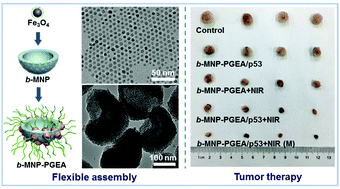A flexible bowl-shaped magnetic assembly for multifunctional gene delivery systems†
Abstract
Magnetic assemblies with special morphologies are promising for versatile biomedical applications due to their intriguing properties and performances. In this work, a polycation-functionalized bowl-shaped magnetic assembly (b-MNP-PGEA) was constructed for magnetic resonance imaging (MRI)-guided synergistic cancer therapy. Taking advantage of distinct properties of Fe3O4 nanoparticles, self-assembly concept, morphology control, and appropriate surface functionalization, the as-prepared magnetic assembly with special morphology was expected to work as a multifunctional carrier to realize the combination of magnetofection and photothermal therapy (PTT). The morphology effect of the magnetic assembly on cellular uptake and the subsequent gene transfection were investigated. The feasibility of the magnetic and photothermal carriers for MRI and complementary PTT/gene therapy was also studied. In addition, the excellent in vivo performance of the proposed bowl-shaped multifunctional carriers was demonstrated using a mouse breast cancer model. Interestingly, synergistic effects based on PTT-enhanced gene therapy were achieved. The facile assembly strategy for the development of special bowl-shaped magnetic carriers for synergistic PTT/gene therapy provides a new avenue for the versatile construction of efficient theranostic platforms.



 Please wait while we load your content...
Please wait while we load your content...